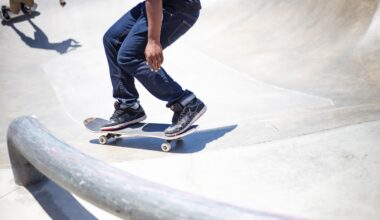Learning the Scissor Kick: When and How to Use It
The scissor kick is a vital technique in swimming that can enhance speed and efficiency in the water. Used primarily in competitive swimming, it combines strength and agility. By utilizing the proper body position and leg movement, swimmers can maximize their propulsion. Mastering this technique not only improves performance but also helps in energy conservation during long swims. When performing the scissor kick, it is important to understand the correct timing and coordination of leg movements. Swimmers should practice isolated leg drills to build strength and familiarity with the technique. Effective practice involves both physical training and a strong mental approach, ensuring a confident execution during races. Consistency in practice will lead to better results and smoother transitions between strokes. Swimmers must take their time to perfect this technique, integrating it into their overall routine. Engaging in strength and flexibility training can also support scissor kick development. Remember, the goal is to create a fluid motion that propels the body forward with minimal resistance against the water. Regular feedback from coaches can facilitate improvement, making the scissor kick a powerful asset in a swimmer’s arsenal.
When learning the scissor kick, swimmers should begin with foundational movements. First, establish a solid understanding of body alignment. The body should remain streamlined, with arms positioned appropriately to support the kick. Kicking improperly can lead to inefficient swimming and fatigue. The legs should move in a coordinated manner, mimicking the scissor motion, which entails crossing the legs while generating force. Consistent practice can develop muscle memory, enabling a swimmer to perform the kick instinctively. It is essential to build both flexibility and strength in the hip joints, enhancing the overall effectiveness of the kick. Incorporating specific exercises, such as flutter kicks and vertical kicks, can improve muscle engagement. Whether training in the pool or dry land, focusing on core stability will contribute to better control during the kick. Engaging the core not only supports leg movement but also enhances overall body position in the water. Furthermore, swimmers should pay attention to breathing techniques while executing the kick. Proper breathing prevents exhaustion and allows for longer training sessions. Practicing the scissor kick regularly also fosters confidence, enabling swimmers to use the kick effectively during competitions and various swimming events.
Drills to Enhance Scissor Kick Technique
Incorporating specific drills into training can significantly enhance a swimmer’s scissor kick technique. One effective drill involves performing scissor kicks while holding onto the wall; this allows for better focus on leg movement. Swimmers can also practice scissor kicks while using a kickboard to provide additional support. By isolating leg movements, swimmers can enhance their strength and agility in executing the kick. Practicing these drills regularly aids in reinforcing proper form and helps identify areas for improvement. Another useful drill is performing the scissor kick while completing sets of laps. This drill simulates race conditions, enabling swimmers to practice stamina and pacing while maintaining form. Additionally, engaging in underwater kicking can further develop leg strength while helping swimmers to simulate the scissor kick without visible distractions. Coordination exercises, such as alternate kicking drills, can develop the timing needed for smoother scissor kicks. Swimmers should also record their practices for a video analysis to see what works best for them. Coaches can provide valuable insight through this analysis, ensuring correct execution that enhances performance during competitive swimming.
Furthermore, understanding the biomechanics of the scissor kick is crucial to mastering the technique. This involves studying how the body’s movement through the water creates propulsion and reduces resistance. An awareness of body position and the angle of leg movements enables swimmers to optimize their kicks. Maintaining a streamlined body while performing the kick allows for less drag, increasing efficiency. Swimmers must also remember to focus on ankle flexibility, as this flexibility contributes to a smoother and more powerful kick. Strengthening the hip flexors is also beneficial, allowing for a greater range of motion. Engaging in cross-training activities, such as cycling or leg weights, can improve performance in the water. In addition, despite how fast or powerful the kick might be, maintaining proper technique should remain the priority. Swimmers should not sacrifice form for speed; a well-executed scissor kick will yield better results in the long term. The journey of perfecting the scissor kick takes time and dedication. Ultimately, patience is key. Recognizing personal growth as improvement is made will encourage ongoing participation in swimming.
Common Mistakes to Avoid
While training for the scissor kick, swimmers often make common mistakes that hinder performance. One major mistake is not maintaining a proper body position during the kick. Allowing the hips to sink can lead to increased drag and decreased propulsion. Swimmers should aim to keep their hips at the water’s surface by engaging the core muscles throughout the kick. Additionally, many swimmers cross their legs too soon during the scissor motion, which disrupts fluidity. This can result in an inefficient kick that does not contribute effectively to speed. Another common mistake is not using the entire leg; some swimmers only use their knees instead of engaging their hips and feet. To have an effective scissor kick, all parts of the leg should work together seamlessly. Swimmers must ensure their toes are pointed and feet are relaxed to optimize thrust. Lastly, it is crucial to avoid kicking with too much force. A common misconception is that more power equals more propulsion. In reality, a well-coordinated scissor kick drives a swimmer forward without excessive effort, preserving energy for extended swimming sessions. Continuous improvement comes through examination and adjustment of these common errors.
The scissor kick can also be utilized in various swimming strokes, including freestyle and breaststroke. Its adaptability makes it a versatile tool for swimmers of all levels. When integrated into freestyle, the scissor kick enhances propulsion during the breathing phase while providing a temporary escape from traditional flutter kicks. Swimmers can alternate between the two to maintain speed and introduce variety. In breaststroke, the scissor kick offers a unique method of breaking the surface for greater efficiency. By using a wider scissor motion, swimmers can effectively maximize their reach during each stroke. It’s important to note that the transition between kick types should be smooth, preserving rhythm throughout the stroke cycles. This versatility emphasizes the importance of mastering the scissor kick as an essential technique. It adds a different dimension to training, promoting endurance and creativity in practice sessions. Swimmers are encouraged to explore when and how to deploy the scissor kick in various competitions. Over time, with focused practice, they will learn to incorporate it as a natural part of their swimming repertoire, creating a distinct advantage when racing.
Conclusion: Perfecting the Scissor Kick
Ultimately, perfecting the scissor kick involves determination, practice, and thoughtful execution. While it may take time to master, the benefits are substantial. A strong scissor kick enhances overall swimming efficiency and can lead to improved race times. Swimmers are encouraged to focus on technique, seeking feedback from coaches and fellow swimmers. This collaborative approach promotes continuous learning and growth. As swimmers integrate the scissor kick into regular practice, they develop strength and conditioning that carries over to increased performance across all strokes. Throughout this journey, self-evaluation remains essential. Recognizing personal progress is crucial in remaining motivated and committed to training. As swimmers continue to refine their skills, they may find their confidence blooming in various aquatic environments. Thus, mastery of the scissor kick becomes not only a technique but also a part of their identity as a swimmer. By embracing the scissor kick, athletes can unlock new potentials in their performance and inspire others within their swim community to cherish the art of swimming. Therefore, dive back in and enjoy the journey ahead as you conquer the scissor kick and all its benefits!
Developing a successful scissor kick is a continuous journey that every swimmer should appreciate. Consistent practice combined with expert feedback will lead to greatness in this technique. While mastering the scissor kick is paramount, it is essential to engage in comprehensive training that fosters overall swimming skills. By doing so, swimmers can enjoy a fulfilling experience in the water, forging strong connections with their training methods and their abilities. Let this journey of improvement in the scissor kick inspire your swimming pursuits!


